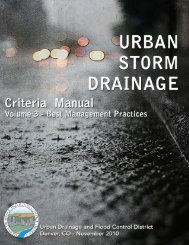Hydraulic Efficiency of Grate and Curb Inlets - Urban Drainage and ...
Hydraulic Efficiency of Grate and Curb Inlets - Urban Drainage and ...
Hydraulic Efficiency of Grate and Curb Inlets - Urban Drainage and ...
Create successful ePaper yourself
Turn your PDF publications into a flip-book with our unique Google optimized e-Paper software.
Note<br />
Safety<br />
Bar<br />
Figure 3-28: R5 with safety bar photograph<br />
3.4 Model Operation <strong>and</strong> Testing Procedures<br />
A headbox was used to supply water to the model, a flume section contained the street<br />
<strong>and</strong> inlet components, <strong>and</strong> a tailbox was used to catch flow that bypassed the inlets. Figure 3-29<br />
provides a sketch <strong>of</strong> the entire model. Water flowed from the inlet valve to the headbox, through<br />
the flume section, then exits into the tailbox. Two pumps fed water to the headbox through a<br />
network <strong>of</strong> large pipes <strong>and</strong> valves. A 40-horsepower (hp) pump was used for the 0.33-ft <strong>and</strong><br />
0.50-ft prototype-scale depths, <strong>and</strong> a 75-hp pump was used for the 1-ft prototype-scale flow<br />
depth. Both pumps drew water from a sump located beneath the laboratory floor, which was<br />
approximately 1 acre ft in volume. Lined channels below the flume conveyed flow away from<br />
the tailbox <strong>and</strong> back into the sump.<br />
38
















